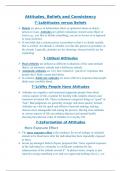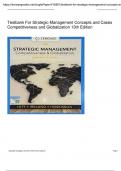Medische microbiologie:
Inleiding:
Verschillende micro-organismen:
Bacteriën
Virussen
Schimmels en gisten
Algen
Protozoa
Welke factoren zorgen voor een geschikte omgeving?
C-bron, N-bron
Gistextract
Water
Voedselbestanddelen/groeifactoren (vitaminen, mineralen,...)
pH
temperatuur
Zuurstofgehalte
Osmotische druk
Verschillende facetten:
Medische microbiologie
Voedingsmiddelenmicrobiologie
Industriële microbiologie (biotechnologie)
Geneesmiddelenindustrie (research)
Milieumicrobiologie
Epidemiologie:
Pathologie (studie van de ziekte)
Etiologie (oorzaak van de ziekte)
Pathogenese (ontwikkeling van de ziekte)
Finale effecten
In de medische microbiologie isoleren en identificeren pathogenen en bepalen we de gevoeligheid.
Door te isoleren verkrijg je losliggende kolonies. Er zijn 2 manieren op een zuivere cultuur of op een
reincultuur. Alleen reinculturen kunnen worden geïdentificeerd. Identificeren van micro-organismen
gebeurt via macro-, microscopisch en biochemisch onderzoek.
Macro: uiterlijk van kolonies (grootte/pigmentatie/vorm/rand/hoogte/oppervlak kenmerken
Micro: RMO/gram (morfologie/onderlinge ligging(rangschikking)
Biochemisch onderzoek: elk m.o. een eigen set biochemische eigenschappen (biochemische
vingerafdruk)
De identificatie is gebaseerd op waarnemingen i.v.m.:
, Morfologie (na kleuring)
Kleurreacties
Groeikarakteristieken op diverse media
Omgevingsatmosfeer
Temperatuurtolerantie
Zouttolerantie
Galtolerantie
pigmentproductie
Eenvoudige biochemische reacties
→biologische klassificatie die internationaal aanvaard is
Verschillende testen:
o Koolhydraatfermentatie
o Waterstofsulfide (H2S) productie
o Indoltest
o Citraatverbruik
o Ureasetest
o Nitraatreductie
o Oxidasetest
o Katalasetest
Gevoeligheid voor chemische stoffen en antibiotica agardiffusiemethode
Antimicrobiële middelen zijn stoffen, geproduceert door
m.o., die andere m.o. doden (microbicide werking) of de
groei ervan remmen ( microbiostatische werking)
o Agardiffusiemethode (= Kirby Bauer methode)
o Antibioticumverdunningsmethode ( in
cultuurbuizen, E-test)
Pigmentproduktie antibioticumverdunningsm.
Hemolyse (α, β en γ)
Groeikarakteristieken op media:
De afmeting van de kolonie
De kolonievorm
De hoogte
De randen
Het oppervlak
Optische eigenschappen
Algemene vaste en vloeibare media:
, MH
BA
CHOC
...
TSB
Thioglycolaat bouillon
Selectieve media:
Gedemineraliseerd Water
Voedingsstoffen
Geleermiddel
Agar/agar (vaste voedingsbodems)
Samenstelling:
Groeibevorderende stoffen
Om groei van gewenste M.O. te stimuleren
Selectieve stoffen
Om groei van ongewenste M.O. te remmen
Electieve stoffen
Gewenste kolonies een specifiek uiterlijk geven
Differentiërende media:
electieve stoffen: kenmerkende veranderingen in het uiterlijk van de kolonie en/of medium
Chromogene media
Bodem Algemee Selectieve Groei van Electieve stoffen Kleur
n stoffen
Selectief
Electief
MCA S+E Galzouten Gram- Lactose - wit kleurloos
McConkey Kristalviolet neutraalrood + roos rood
Agar (neerslag
galzouten)
EMB S+E Eosine Gram- Lactose - doorzichtig
Eosine methyl methyleenblauw + paar-
blauw metaalgeel
MSA S+E NaCl Staphylococcen Mannitol fenolrood - wit (id
Manitol Salt bodem)
Agar + geel ((bod.-
rood)
CLED A+E - Gram + en - Lactose - kleurloos
Cystine broomthymolblauw + geel
Lactose
Electrolyt
deficient
Aanrijkingsmedia:
, Selenietbouillon
Rappaportmedium
Specifieke isolatiebodems:
Legionellamedium
Thaeyer-Martin-agar (Neisseria)
Campylobacteragar
Löwenstein-Jensen-bodem (mycobacteriën)
...
Inleiding:
Verschillende micro-organismen:
Bacteriën
Virussen
Schimmels en gisten
Algen
Protozoa
Welke factoren zorgen voor een geschikte omgeving?
C-bron, N-bron
Gistextract
Water
Voedselbestanddelen/groeifactoren (vitaminen, mineralen,...)
pH
temperatuur
Zuurstofgehalte
Osmotische druk
Verschillende facetten:
Medische microbiologie
Voedingsmiddelenmicrobiologie
Industriële microbiologie (biotechnologie)
Geneesmiddelenindustrie (research)
Milieumicrobiologie
Epidemiologie:
Pathologie (studie van de ziekte)
Etiologie (oorzaak van de ziekte)
Pathogenese (ontwikkeling van de ziekte)
Finale effecten
In de medische microbiologie isoleren en identificeren pathogenen en bepalen we de gevoeligheid.
Door te isoleren verkrijg je losliggende kolonies. Er zijn 2 manieren op een zuivere cultuur of op een
reincultuur. Alleen reinculturen kunnen worden geïdentificeerd. Identificeren van micro-organismen
gebeurt via macro-, microscopisch en biochemisch onderzoek.
Macro: uiterlijk van kolonies (grootte/pigmentatie/vorm/rand/hoogte/oppervlak kenmerken
Micro: RMO/gram (morfologie/onderlinge ligging(rangschikking)
Biochemisch onderzoek: elk m.o. een eigen set biochemische eigenschappen (biochemische
vingerafdruk)
De identificatie is gebaseerd op waarnemingen i.v.m.:
, Morfologie (na kleuring)
Kleurreacties
Groeikarakteristieken op diverse media
Omgevingsatmosfeer
Temperatuurtolerantie
Zouttolerantie
Galtolerantie
pigmentproductie
Eenvoudige biochemische reacties
→biologische klassificatie die internationaal aanvaard is
Verschillende testen:
o Koolhydraatfermentatie
o Waterstofsulfide (H2S) productie
o Indoltest
o Citraatverbruik
o Ureasetest
o Nitraatreductie
o Oxidasetest
o Katalasetest
Gevoeligheid voor chemische stoffen en antibiotica agardiffusiemethode
Antimicrobiële middelen zijn stoffen, geproduceert door
m.o., die andere m.o. doden (microbicide werking) of de
groei ervan remmen ( microbiostatische werking)
o Agardiffusiemethode (= Kirby Bauer methode)
o Antibioticumverdunningsmethode ( in
cultuurbuizen, E-test)
Pigmentproduktie antibioticumverdunningsm.
Hemolyse (α, β en γ)
Groeikarakteristieken op media:
De afmeting van de kolonie
De kolonievorm
De hoogte
De randen
Het oppervlak
Optische eigenschappen
Algemene vaste en vloeibare media:
, MH
BA
CHOC
...
TSB
Thioglycolaat bouillon
Selectieve media:
Gedemineraliseerd Water
Voedingsstoffen
Geleermiddel
Agar/agar (vaste voedingsbodems)
Samenstelling:
Groeibevorderende stoffen
Om groei van gewenste M.O. te stimuleren
Selectieve stoffen
Om groei van ongewenste M.O. te remmen
Electieve stoffen
Gewenste kolonies een specifiek uiterlijk geven
Differentiërende media:
electieve stoffen: kenmerkende veranderingen in het uiterlijk van de kolonie en/of medium
Chromogene media
Bodem Algemee Selectieve Groei van Electieve stoffen Kleur
n stoffen
Selectief
Electief
MCA S+E Galzouten Gram- Lactose - wit kleurloos
McConkey Kristalviolet neutraalrood + roos rood
Agar (neerslag
galzouten)
EMB S+E Eosine Gram- Lactose - doorzichtig
Eosine methyl methyleenblauw + paar-
blauw metaalgeel
MSA S+E NaCl Staphylococcen Mannitol fenolrood - wit (id
Manitol Salt bodem)
Agar + geel ((bod.-
rood)
CLED A+E - Gram + en - Lactose - kleurloos
Cystine broomthymolblauw + geel
Lactose
Electrolyt
deficient
Aanrijkingsmedia:
, Selenietbouillon
Rappaportmedium
Specifieke isolatiebodems:
Legionellamedium
Thaeyer-Martin-agar (Neisseria)
Campylobacteragar
Löwenstein-Jensen-bodem (mycobacteriën)
...




